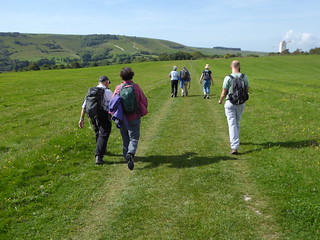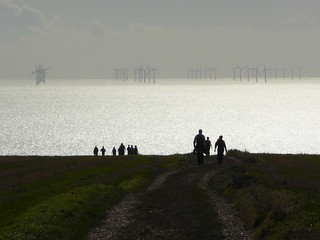Lewes to Saltdean Walk
South Downs Way along a chalk ridge in the morning, remote Rodmell for lunch, then back up and over the downs to the coast. Undercliff path, or bus to Brighton

First view of the downs
Lewes to Saltdean walk
Sep-18 • Saturdaywalker on Flickr
swcwalks book2 walk24 banner 31226283188

On the downs
Lewes to Saltdean walk
Sep-18 • Saturdaywalker on Flickr
swcwalks book2 walk24 walkicon 45050709022

Descending to Rodmell
Lewes to Saltdean walk
Sep-18 • Saturdaywalker on Flickr
swcwalks book2 walk24 walkicon 43286187830

Descending to Saltdean
Lewes to Saltdean walk
Sep-18 • Saturdaywalker on Flickr
swcwalks book2 walk24 walkicon 45050708862

| Length |
15.5km (9.6 miles). For a shorter walk and other variations, see below Walk options. Time: 4 hours 45 minutes. For the whole outing, including trains, sights and meals, allow at least 9 hours. |
|---|---|
| Transport |
Twice hourly trains run between London Victoria and Lewes (journey time: 1 hour 5 minutes). Take the nearest train to 9.30am. From London Bridge and other Thameslink stations, you can change at East Croydon for the train from Victoria. If not walking onto Brighton from Saltdean, there is a frequent coastal bus service to Brighton. A return rail ticket to Lewes is valid from Brighton. For those driving, park centrally in Lewes; the train station has a car park. |
| OS Maps |
OS Landranger Map: 198 OS Explorer Map: OL11 (formerly 122) Lewes, map reference TQ416098, is in East Sussex. |
| Toughness |
4 out of 10. |
| Walk notes |
This fine South Downs walk follows ridges of chalk grassland offering panoramic views in all directions. It begins in the historic town of Lewes, then the route quickly rises to follow a ridge along the top of the Downs before descending for lunch to the picturesque and historic village of Rodmell with its literary associations. In the afternoon it gently climbs back over the Downs to the sea to emerge at the town of Saltdean, with the option to continue for a further 8.5 km to Brighton. |
| Walk Options | The directions for the following variations appear at the end of the main walk text. (see p260). a) Alternative return to Lewes via Northease Manor: This route, which is lower-lying than the main walk route, takes you inland via Northease Manor. You follow the main walk directions to point [5], then follow the directions for this option at the end of the main walk text. b) Shorter walk ending at Southease: You can reduce the length of the walk to 12.5km (7.8 miles) by ending at Southease and returning by train to Lewes from there. Follow the main walk directions until point [5], then follow the directions at the end of the main walk text. c) Lewes to Seaford walk (via South Downs): For the ultimate, invigorating long walk (24.8km/15.4 miles) from Lewes to Seaford, you can take the short walk option (b) above, ending at Southease station, then take the separate Southease to Seaford (walk 26, option (a) in this book) which starts at Southease station. |
| History |
Lewes Castle (tel 01273 486 290) and the Barbican House Museum nearby are open to visitors until 5.30pm daily (last entrance 5pm). The castle, which is visible for much of this walk, was built around 1070 by William de Warenne who fought alongside William the Conqueror at the Battle of Hastings. In the 1264 Battle of Lewes the rebel Earl of Leicester, Simon de Montfort, with an army of Londoners and 5,000 barons, defeated Henry III leading to England's first parliamentary meeting at Westminster in 1265. Lewes Priory Only the ruins of the priory remain as the church, which was as large as Westminster cathedral, was demolished during Henry VIII's dissolution of monasteries. The Priory of St. Pancras was also founded by William de Warenne. Anne of Cleves House, Lewes (tel 01273 474610) is a 16th century timber framed Wealden house given by Henry VIII to Anne of Cleves as part of their divorce settlement, but she never lived there. The house now contains the museum of Lewes charting the town's history from the 16th Century to the present day. It is open to visitors from 10am to 5pm,Tuesday to Saturday and 11am to 5pm on Monday and Sunday. Admission is £2.80. Southover Grange House and Gardens, Lewes An Elizabethan house built in 1572 by William Newton, using Caen stones from the ruins of Southover Priory. John Evelyn the diarist lived here while attending grammar school. Monk's House, Rodmell (tel 01892 890651)was the home of Virginia and Leonard Woolf who lived here from 1919 until Virginia's suicide in March 1941 (when she filled her pockets with stones and drowned herself in the river). Her ashes are buried in the garden. Leonard remained here until his death in 1969. Visitors to the house during the years they spent here included Vita Sackville-West, Lytton Strachey, E. M. Forster, Maynard Keynes, T. S. Eliot and Roger Fry. The house is open to visitors on Wednesday and Saturday afternoons, April to the end of October 2pm to 5.30pm. Admission is £2.60. |
| Lunch and Tea |
|
| Book |
This walk was originally published in Time Out Country Walks near London volume 2. We now recommend using this online version as the book is dated. |
|---|---|
| Profile | |
| Help Us! |
After the walk, please leave a comment, it really helps. Thanks! You can also upload photos to the SWC Group on Flickr (upload your photos) and videos to Youtube. This walk's tags are: |
| By Train |
Out (not a train station) Back (not a train station) |
| By Car |
Start Map Directions Finish Map Directions |
| Amazon | |
| Help |
National Rail: 03457 48 49 50 • Traveline (bus times): 0871 200 22 33 (12p/min) • TFL (London) : 0343 222 1234 |
| Version |
Aug-23 Sylvia |
| Copyright | © Saturday Walkers Club. All Rights Reserved. No commercial use. No copying. No derivatives. Free with attribution for one time non-commercial use only. www.walkingclub.org.uk/site/license.shtml |
Walk Directions
Full directions for this walk are in a PDF file (link above) which you can print, or download on to a Kindle, tablet, or smartphone.
This is just the introduction. This walk's detailed directions are in a PDF available from wwww.walkingclub.org.uk



